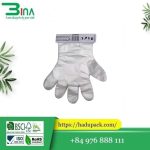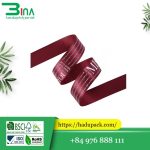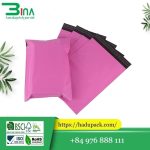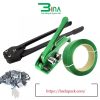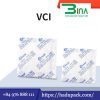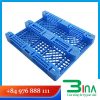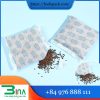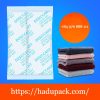1 kg plastic bags, about how many bags?
Plastic bags, plastic bag are one of the familiar items at fashion stores, supermarkets, grocery stores, markets…. And they come in many different sizes, colors, designs, and models. Many customers wonder, 1kg includes how many plastic bags or foam bags, are the bags of the same quantity or not?
Other uses for plastic bags
Don’t use plastic bags as garbage bags anymore, there are at least 30 uses you haven’t tried! Like me, many people will buy another plastic bag.
But when I buy it, I often use it as a garbage bag. However, I heard there are 30 unknown uses of garbage bags, do you want to try it together?
- White vest is difficult to wash: In the summer, a long-wearing white vest will not be clean. You can wash your white vest first with clean water, then gently rub it with soap or detergent. After washing, apply soap or washing powder and then gently rub, do not rub anymore, put in a plastic bag tied to the mouth, dry in the sun for 1 hour. Then take it out and scrub it so it’s as white as ever.
- Helps clothes not to wrinkle: When folding clothes, you should fold the plastic bag inside the clothes, keep the clothes separately from the plastic bag. This way, when some are pressed, the plastic cushions some of the pressure, and at the same time can slow down the friction between the materials, so it’s generally not prone to wrinkling.
- Helps leather shoes resist mildew: First wipe the leather shoes with a damp cloth, dry, apply shoe polish, wait for a while, use a shoe polish brush to polish, put in a sealed plastic bag, exhaust all the air in the bag, tie the bag tightly with a string. rope. Storing leather shoes in this way can help prevent leather shoes from cracking, deforming, moldy and damaged.
- Prevent windows from freezing flowers: Residents who use the stove for heating in winter often have frost on the window glass in the house due to the morning steam, after the ice melts, the water will not stop flowing on the windowsill. If there is a screen window outside the window, white plastic film can be nailed to the wooden frame of the screen window so that the window glass does not freeze and resists cold.
- Prevention and treatment of cracked heels: Wash the foot with warm water, wrap a clean, transparent, soft and thin plastic bag on the heel, then put on socks, so that the cracked part is always warm and wet, the injured part will heal quickly. . within 3 to 4 days.
- Reserve chestnuts: Chestnuts are packed in plastic bags and placed in a well-ventilated, temperature-stable basement. When the temperature is above 10°C, open the plastic bag, when the temperature is below 10°C, tightly tie the plastic bag for storage. Spinning every 7 days to 10 days at first, after a month it can be reasonably reduced.
- Preserving radishes from spoiling: Before and after the winter solstice, dry the radishes in the sun until the surface of the radish dries up in the shade, put it in a plastic bag, and tie the bag tightly with a string to prevent the radish from becoming mushy. damaged after being stored for two months.
- Braised cabbage: In winter, cabbage can be stored in non-toxic plastic bags. When the indoor temperature is too low, you can use a plastic bag to wrap the whole cabbage and tie the top of the bag, if the temperature is above 0°C, you can use a plastic bag to wrap the cabbage from the top down without tying. roots to the ground.
- Storing leeks: Put fresh leeks in a plastic bag and store in a cool place, can keep fresh for 3 days.
- Preserve sea cucumbers without damage: Sun-dried sea cucumbers, put in a non-toxic double-layer plastic bag, tie tightly, hang in a ventilated, dry place. In the summer, sunbathe many times, using this way to preserve sea cucumbers for a long time will not deteriorate.
- Store rice without moisture: Put the rice in a composite plastic food bag, squeeze out all the air in the bag, use a string to tie the bag close to the rice so that the rice does not get moldy.
- Save red dates in summer: At the end of spring, put the jujubes out in the sun for a few days, rub with salt, then let it cool, put a layer of red dates and a layer of salt in a plastic bag, cover, so that the jujube can survive the summer properly. safe.
- Fresh Celery: Some celery is temporarily inedible, you can pick up the yellow, shriveled leaves, bundle them into small bundles, put them in a non-toxic polyethylene plastic bag, slightly longer than the celery plant, and tie loosely. Bag mouth, store in a cool place, low temperature, timely store in a cool place, check ventilation, can keep fresh for several days.
- Long-term apple preservation: Choose a delicious, undamaged apple, cover the surface with paper, then put it in a plastic food bag, tie the bag tightly and tie it tightly, store it in a room with a low temperature or a shady balcony. in a few months to half a year.
- Ripe Raw Bananas: You can put about 5 kg of bananas in a plastic bag, then put it in a bowl or teacup with dry sand or ash inside, break it in half with 10 incense sticks, plug it into a sand-filled container, and burn it. them and tie them tightly Only the bag.
- Helps persimmons get rid of the acrid taste: Find a clean, intact plastic bag and arrange the persimmons next to each other, depending on the number of persimmons, choose 1 to 2 pears arranged around the persimmon, then tie the plastic bag tightly and put it in place. Cool for about a week before eating.
- Preserving dried chili: Skewer the peppers and dry completely. Take a suitable sized plastic bag, thread the chili wire through the bottom of the plastic bag and hang it under the eaves. Every 1 to 2 months, remove the plastic bag to dry the peppers. In this way, chili will not be damaged by insects but also clean and hygienic.
- Preserved coriander: Bundle fresh coriander into small bunches, wrap a layer of paper, put the root in a plastic bag, tie it lightly and then turn the stem down, put it in a cool place. Store cilantro this way and it will stay fresh for up to a week.
- Save the dough for the summer: Roll the starter into a round ball, put in a non-toxic plastic bag, tie the bag tightly, store in a cool place, can be used in the summer for 3 to 4 days.
- Preserving fresh mushrooms: Fresh mushrooms contain a lot of water, soft tissue, easily damaged, can be soaked in brine to keep fresh. Soak the mushrooms in 0.6% salt water for 10 minutes, take them out to dry, put them in a plastic bag to keep fresh for 3 to 5 days.
- Preserving black tubers for a long time: Black fungus is wrapped in plastic film and placed in a cool, dry place, not easily affected by moisture, can be stored for several years without damage.
- Avoid moldy yuba: Choose good quality tofu sticks, dry to keep the water content about 12% to 14%, then put them in plastic food bags, tie the bag tightly and store in a cool and dry place. below 33°C to avoid contamination, mold.
- Preserving cucumbers: Put fresh, young, undamaged cucumbers that have just been picked or bought into small plastic food bags, each bag from 1 kg to 1.5 kg, loosely tied the mouth of the bag, in a cool place in the house, can be stored. in the fridge. can be stored for 4 to 7 days in summer, when the indoor temperature is low in autumn and winter can be stored for 8 to 15 days.
- Long-term preservation of garlic: Timely harvested garlic is selected and dried, cut off the garlic stem and roots, put in a non-toxic polyethylene plastic film bag, sealed the mouth of the bag, so it can be preserved for a long time without harm. damaged. During storage, the bag should be opened every two weeks for ventilation.
- Preserving garlic sprouts: Pick up the bulging garlic sprouts, the old moss stalks, the parts that are too thin, too short, injured, leaving the bulbs intact, using a plastic bag to tie the handle, each clove weighs about 1,000 grams. peel and cut the bracts, long antennae, leave bracts 5cm long, then put the garlic sprouts on the vegetable rack to cool before 24 hours, then put in a plastic bag to preserve, tie the bag tightly, put in a place where low temperature, can be stored for a good period of time.
- Long-term preservation of tomatoes: Select tomatoes at the green and ripe stage, put in a shady place for preliminary cooling, remove injured and diseased fruits, and put them in polyethylene plastic film bags. Each bag is about 3 kg to 5 kg, stored in sealed bags, at 28°C to 30°C can be stored from 10 days to 15 days, at 12°C to 17°C can be stored from 15 days to 20 days, at 10°C to 12°C, it can be stored for 20 to 30 days. During storage, the bag should be opened once every 3 or 4 days to allow ventilation.
- Dry bread becomes soft again: Wrap the dry bread in the original packaging with wax paper, cover the outside with absorbent paper, then put in a plastic bag dipped in water, tie the bag tightly, leave overnight, the bread will soften. .
- Save rice: When stewing rice, add 500 grams of rice to 20 grams of vinegar, the stewed rice does not have a sour taste but is easier to preserve. When stewing rice, add 0.5% acetic acid solution according to the above dosage, then put the stewed rice in a sealed plastic bag, leave it for a while in a cool environment.
- Prevent wool from tangling: When knitting sweaters, if you are using more than two wool balls at the same time, you can put them in the same plastic bag, so that the thread end of each yarn passes through different holes in the bag, preventing the wool from twisting. during weaving.
- Leaky Water Pipe Protection: Washing machine drain pipes often leak due to bending and aging. You can use a 10cm wide plastic bag to wrap several layers at the crack of the drain pipe and then use a longer nylon cord to wrap it from one end to the other end of the plastic bag in a spiral groove. to prevent clogging. Seal cracks in water pipes to prevent water pipes from leaking.
The reason why plastic bags are popular and widely used
Plastic bags have many outstanding advantages, so they are widely applied in life. Here are some advantages of plastic bags.
Features of nylon bag:
- Thin, surface with moderate gloss and clarity
- High water resistance but poor breathability
- The hardness is better than other plastic bags
- Flexibility is average
- Low elongation
- Easy to create folds, wrinkles when folding bags, rubbing
First, we must know that the formula for density is:
- D = M/V
- D = Density; M = Mass; V = Mass
As the formula indicates, density is the total mass of the object divided by the total volume of the object, which means: 1 gram per cubic centimeter or 1 kilogram per cubic meter.
The density of water is 1 gram per cubic centimeter (1 g/cm3), but actually, the exact density of water is not really 1 g/cm3, but a little (very, very little) less than 1. , so we can say that in general the weight and volume of water are the same.
What is the meaning of “Specific Gravity”?
Specific gravity means the specific value of an object at normal temperature and pressure.
The formula or specific gravity is:
- Specific gravity = Object / DH2O
- Dobject = Density of the object; DH2O = Density of water
Difference of Density & Specific Gravity
“Density” has its own unit of measure, 1 g/cm3 or 1 kg/m3, conversely, density has no associated unit of measure; however, although they do not have the same meaning, they have the same value because the density of water is quite close to 1g/cm3.
That is, 1 cm3 of water weighs 1 g (as said the density of water is 1g/cm3) and 1 cm3 of aluminum weighs 2.7 g (density is 2.7 g/cm3) so the density of aluminum is 2.7 1 = 2.7 (same value as density)
| Plastic material | Density (g/cm3) / Specific gravity |
| LDPE | 0.92 – 0.94 |
| LLDPE | 0.92 – 0.95 |
| PP Copolymer | 0.90 – 0.91 |
| PET | 1.30 – 1.40 |
| PVC PLASTICIZED | 1.30 – 1.70 |
| EVA | 0.92 – 0.94 |
| HDPE | 0.94 – 0.97 |
| PA | 0.9 |
Example of how to calculate the number of plastic bags/kg:
1.Example 1: PA/PE vacuum bags have the following dimensions: Width x Length x Thickness = 28cm x 40cm x 100mic
Weight of PA/PE bag= Width x Length x Thickness x specific gravity= ((28 x 40 x 0.0015)x0.9 + (28 x 40 x 0.0085) x 0.092) x 2= 22g => So 1kg has 1000/ 22= 45 bags, here PA=15mic; PE=100mic-15mic=85mic.
2.Example 2: PE bag has the following dimensions: Width x Length x Thickness = 28cm x 40cm x 50mic
Weight of PE bag=Width x Length x Thickness x specific gravity= (28 x 40 x 0.005)x0.92x 2= 10g => So 1kg PE bag has 1000/10= 100 bags.
Of course, there will be errors, because the width, length, thickness, and specific gravity themselves all have tolerances.


